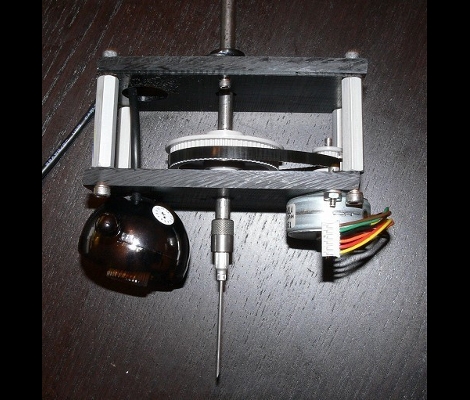
This is a vacuum tweezers head for an open source pick-and-place. Those are the machines that professional printed circuit board manufacturers use to populate a circuit board with components before heading to the reflow oven. [Drmn4ea] built it with at-home rapid manufacturing in mind. The black orb on the left is a webcam for optical placement. The needle in the middle is an interchangeable vacuum-tool head. The motor on the right allows for different attachments to be swapped in automatically to suit a variety of parts.
This interfaces with a 3-axis CNC machine and should be easily compatible with a RepRap, Makerbot, or similar device. We wonder how he plans to handle reels of components, but this is a well-executed first step in the journey to a complete solution.
Want to see a professional pick-and-place at work? Check out one of SparkFun’s machines busy build a board after the break.
[flickr video=http://www.flickr.com/photos/amagill/3449765030/]















I love those machines, it is like watching a fish tank… very soothing.
I bet you wouldnt like it that much if you would have to watch machines like these in some factory all day long. This looks industrial grade.
I never get tired of watching the SMT placement machines, but no one has the time to stand around and watch them. Slack ESD policy, no ESD jackets.
These aren’t too bad to watch all day unless someone changes your z height when you aren’t looking, and parts start getting slammed through boards. This looks like a nice setup, I don’t know that I’d be using a metal nozzle with it though.
I think that motor is for rotating the part for alignment with the PCB, not tool-changing. The knurl for changing the head is visible below the bracket, and is not attached to anything.
I agree this LOOKS like a nice design. Very well thought out (or worked out) and nicely documented. Even the newest of newbie hackers could follow the docs and make this picker.
BUT…
I was hoping to get a look at how much this little gadget can do so far. Apply a vaccuum and attach to an scrapped printer carriage and show it at least moving parts from place to place. I completely understand –based on the description here– that it isn’t yet fully incorporated into “a 3-axis CNC machine and should be easily compatible with a RepRap, Makerbot, or similar device.” But isn’t making that claim at his point somewhat of a leap of faith?
I was hoping to see this picker-n-placer doing something that demonstrates it SHOULD move to the next stage of installing it in a CNC, testing it, then programming, testing again, etc.
No offense intended to [Drmn4ea] or Mike Szczys — just opining (or whining) that there ought to be some proof of function before posting.
@Jack: just want to reaffirm you don’t want to watch a pick and place all day, especially not in a large factory. Took a tour of a local TRW manufacturing plant where they make Honda airbag computers among other things. They use rapid pick and place machines. They can place 5 to 10 parts per second. It’s impressive to watch, but its like standing next to a gas generator, and with 6 of those machines running on one plant floor alone, I was rather ticked off that they didn’t include earplugs with the lab coats and anti-static straps.
I am totally going to build a cnc , and one of these when its finished. In my opinion this is a quality post. Solid start to an incredible project. Caught early on showing thought and good design.
Now I will have to keep checking for updates ;)
I’ve made a similar thing but it uses a hobby servo rather than stepper and pulley hardware. Hopefully the finished pnp machine will make it onto hackaday,
They are fascinating machines, I had the pleasure of working with some this summer. But I agree, you don’t want to have to watch them all day…
After the first couple boards it gets pretty repetitive.
One step closer to skynet…
@andrew, One step closer. I thought it was 2010. Havn’et the robots already taken over already!
We have these machines at work and i dont think i’ve ever felt the urge to stare at it while it runs.
The xray machine for finding BGA solder bridges…now thats kewl to stare at, as long as your eyes are protected :)
p.s. Dear HAD, Wouldn’t it be nice to go back and change misspelled words from a post?
The P&P-machine on the video is SLOOOOW. We have ESSEMTEC machines at my uni embedded production lab and they’re like blazing fast. Also it’s a nice line since it has an automated rack in the beginning and in the end, and a conveyor belt takes boards from a rack to P&P to reflow oven and back into a rack. :)
@pRoFIT
are you speaking of Havn’et, kewl, or the massive amount of i’s? btw not trollin, just askin bro.
@Entropia
How much do those PnP machines in your lab cost? Even the cheapest automated ones from Manncorp are $5K+
This, along with a low cost CNC machine (take a look at Zen CNC) means you could have a simple PnP machine for less than $800.
Frankly, if your building enough for production volume, then you can afford a CM (Contract Manufacturer).
My use for this (I commented on his blog at CEXX) is simple … let me use it build proto’s, while I’m in the lab (garage) working on something else! ;)
Cheers
/R